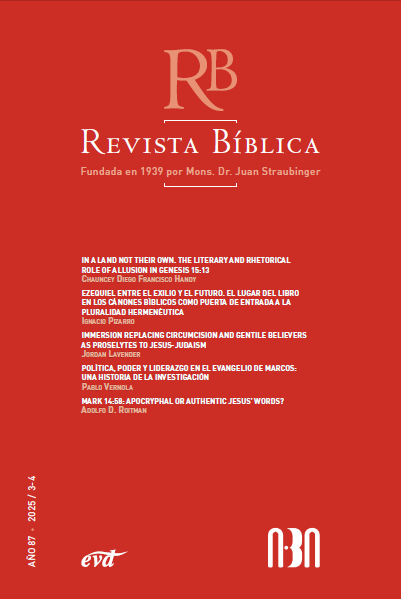In a land not their own
The Literary and Rhetorical Role of Allusion in Genesis 15:13
DOI:
https://doi.org/10.47182/rb.87.n3-4-2025449Keywords:
Genesis, Egypt, Pentateuch, Abraham, implied readerAbstract
I argue that in Genesis 15:13 the phrase “in a land not their own”, be’ere? l?’ l?he, operates at multiple rhetorical levels for ancient diasporic Jewish readers. Firstly, it foreshadows the enslavement in and exodus from Egypt, thus literarily connecting the Abraham cycle to what is to come in later in Exodus. Secondarily, the vagueness of the term, rather than simply saying “Egypt” facilitates the connection of the patriarchal narrative to the lived experience of diasporic readers. “A land that is not their own” refers to Babylon (or other places) just as much as it does to Egypt.
References
Abraham, J., “The Covenant between the Parts”, Jewish Bible Quarterly 36 no. 4 (2008) 231-242.
Anbar, M., “Genesis 15: A Conflation of Two Deuteronomic Narratives”, Journal of Biblical Literature 101 no. 1 (1982) 39-55.
Ben-Mosheh Ben-Asher, A. – K?h?n, M. (eds.), Miqraot gedalot haketer (Bereshit 1) (Hadpasa 2), R?mat-Gan 2008.
Brettler, M. Z., How to Read the Bible, Philadelphia (PA) 12005.
Carr, D., “Narrative and the Real World: An Argument for Continuity”, History and Theory 25 no. 2 (1986) 117-31.
Fidler, R., “Genesis Xv: Sequence and Unity”, Vetus Testamentum 57 no. 2 (March 1, 2007) 162-180.
Friedman, R. E., Who Wrote the Bible? (reprint edition), San Francisco (CA) 1997.
Hasel, G. F., “The Meaning of the Animal Rite in Genesis 15”, Journal for the Study of the Old Testament 19 (1981) 67-78.
Iser, W., The Implied Reader: Patterns of Communication in Prose Fiction from Bunyan to Beckett, Baltimore (MD) 1978.
Peleg, Y. (I.), “Was the Ancestress of Israel in Danger?”, Zeitschrift Für Die Alttestamentliche Wissenschaft 118 no. 2 (January 1, 2006) 197-208.
Römer, T., “The Exodus in the Book of Genesis”, Svensk Exegetisk Årsbok 75 (2010) 1-20.
Sarna, N. M., Genesis =: Be-Reshit: The Traditional Hebrew Text with New JPS Translation (The JPS Torah Commentary), Philadelphia (PA) 1989.
Schmid, K., “Genesis in the Pentateuch”, in A. Craig – A. Evans – J. N. Lohr – D. L. Petersen (eds.), The Book of Genesis. Composition, Reception, and Interpretation (Supplements to Vetus Testamentum, v. 152), Leiden 2012, 27-50.
Ska , J.-L., Introduction to Reading the Pentateuch, Winona Lake (IN) 2006.
van Wieringen, A. L. H. M., The Implied Reader in Isaiah 6-12, Leiden 1998.
von Rad, G., Genesis – A Commentary (revised edition), Philadelphia (PA) 1973.
Wenham, G. J., “The Symbolism of the Animal Rite in Genesis 15: A Response To GF Hasel, Jsot 19 (1981) 61-78”, Journal for the Study of the Old Testament 7 no. 22 (1982) 134-37.
Wenham, G. J. – Hubbard, D. A. – Barker, G. W. – Metzger, B. M., Genesis 1 – 15 (Word Biblical Commentary 1), Waco (TX) 1987.
Westermann, C., Genesis 12-36, Minneapolis (MN)1995.
Zakovitch, Y., “Juxtaposition in the Abraham Cycle”, in D. P. Wright – D. N. Freedman – A. Hurvitz (eds.), Pomegranates and Golden Bells:
Studies in Biblical, Jewish, and Near Eastern Ritual, Law and Literature in Honor of Jacob Milgrom, Winona Lake (IN) 1995, 509-24.
Published
How to Cite
Issue
Section
Copyright (c) 2025 Revista Bíblica

This work is licensed under a Creative Commons Attribution-NonCommercial-ShareAlike 4.0 International License.




